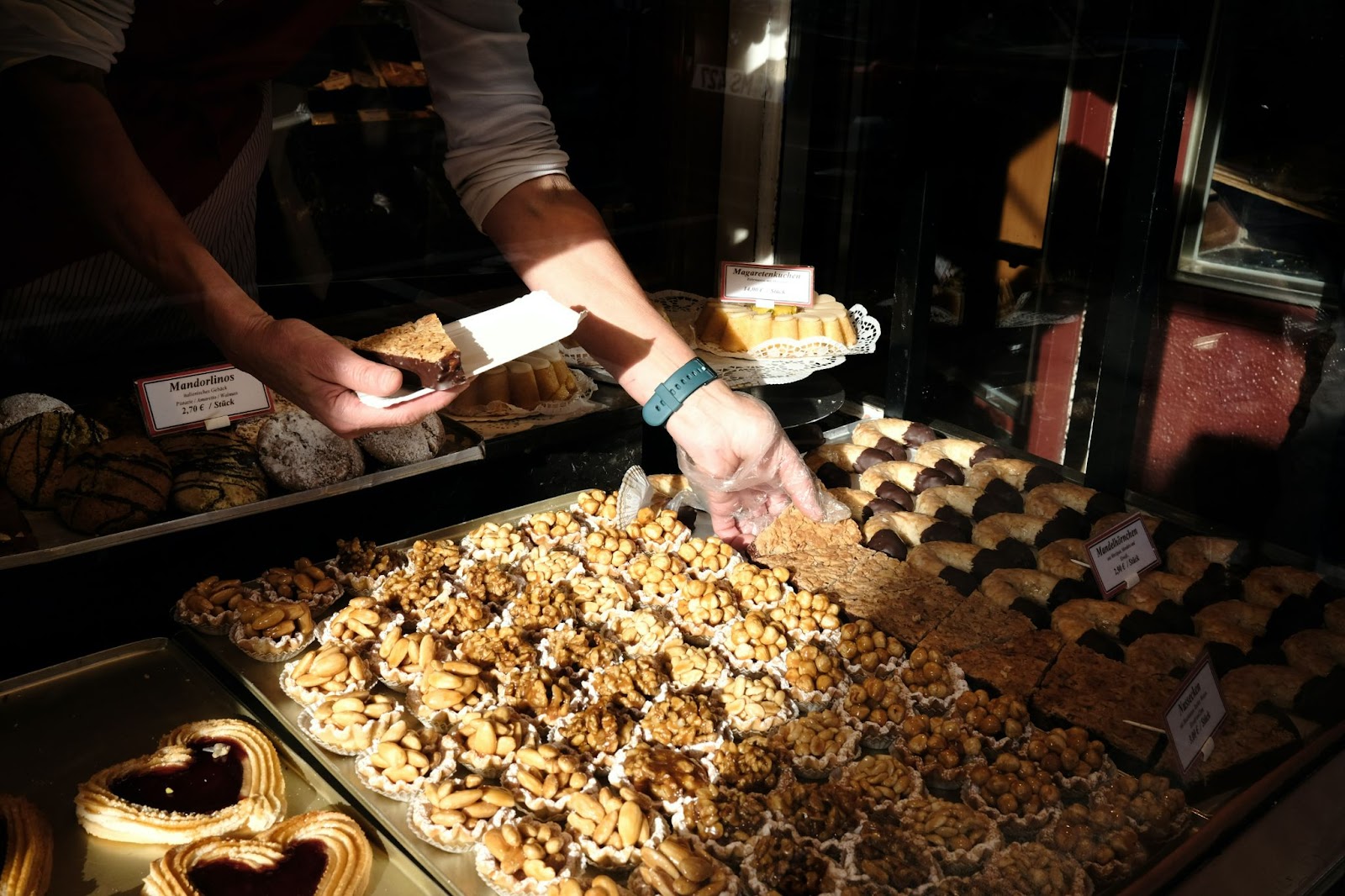The Marketing Plan for Your Baking Business From Home

To start a baking business from home, you need a marketing plan that helps you reach your target customers and grow your business.
Here are some steps to create a marketing plan:
1. Define your target market: Identify who you want to sell your baked goods to, based on demographics like age, location, and interests.
2. Create a brand: Develop a brand identity that reflects the personality and values of your baking business. This includes your business name, logo, color scheme, and tagline.
3. Build a website: Create a website that showcases your baked goods, pricing, and delivery options. Make sure it’s mobile-friendly and easy to navigate.
4. Establish a social media presence: Leverage social media channels like Facebook, Instagram, and Pinterest to promote your baking business, interact with customers, and showcase your latest creations.
5. Offer promotions and discounts: Encourage customers to try your baked goods with promotions like discounts, free samples, and referral programs.
By following these steps, you can create an effective marketing plan for your home baking business, attract more customers, and build a strong brand.
Understanding Your Target Market
Before you can start any marketing plan for your baking business from home, it is important to have a clear understanding of your target market. This will help you create a tailored marketing plan that will be most effective in reaching your target audience.
By understanding your target market’s needs, wants and preferences, you will be better positioned to create a plan that will reach them.
Let’s take a closer look at what you need to consider when understanding your target market.
Define your Ideal Customer
Defining your ideal customer is a crucial step in creating a successful marketing plan for your home-based baking business. Knowing your target market will guide your strategies for product development, pricing, promotion, and distribution.
Here are some tips for defining your ideal customer:
Conduct market research to understand the demographics, psychographics, purchasing behavior, and preferences of your potential customers.
Segment your target market based on shared characteristics and behaviors, such as age, gender, lifestyle, personal interests, or location.
Create customer personas that describe in detail your ideal customers, including their background, goals, challenges, values, and expectations from your baking business.
Use your customer insights to tailor your marketing messages and activities to your target market, and to differentiate your business from competitors.
Identify Your Customers’ Pain Points and Needs
To start a baking business from home, it’s crucial to identify your customers’ pain points and needs. This will help you create a marketing plan that targets your ideal audience effectively.
Here are the steps you can follow:
Research your target market to understand their demographics, such as age, income, and location.
Conduct surveys or polls to gather information about their preferences, habits, and challenges when it comes to baked goods.
Analyze the data to identify common pain points and needs among your target audience, such as dietary restrictions, lack of time or knowledge to bake, or difficulty finding high-quality ingredients.
Develop a unique selling proposition (USP) that addresses your customers’ pain points and needs. For example, you may specialize in gluten-free baking, offer customized orders, or use locally sourced and organic ingredients.
Craft a marketing message and strategy that resonates with your target audience, highlighting the benefits of your USP and addressing their pain points and needs.
Remember to regularly gather feedback from your customers to refine your marketing plan and adapt to their changing needs.
Analyze Your Customers’ Buying Behavior
Analyzing your customers’ buying behavior can provide valuable insights into their preferences, needs, and habits, helping you tailor your marketing strategies and improve your baking business from home.
Some key factors to consider include:
Demographics: Age, gender, income, and education levels can influence your customers’ tastes and expectations.
Psychographics: Values, attitudes, lifestyles, and personality traits can impact their purchasing decisions and brand loyalty.
Behaviors: Buying frequency, average spend, product preferences, and channels used for purchase can reveal patterns and trends in their shopping habits.
Once you have a clear understanding of your target market, you can develop a marketing plan that speaks to their needs and desires, strengthens your brand identity, and maximizes your business growth potential. Pro tip: Conduct surveys, social media polls, and focus groups to gather more data and feedback directly from your customers.
Developing Your Brand Identity
When starting a baking business from home, it is important to create a distinct brand identity that can be conveyed to your target market. Developing a well-rounded brand identity will help attract customers, build loyal relationships and create a good first impression.

This section of the marketing plan will focus on developing your brand identity with the help of logo design, website design and customer service.
Create a Unique Brand Name and Logo
Creating a unique brand name and logo is an essential step in developing your brand identity for your home baking business.
Here are some tips to help you create an effective brand name and logo:
Be unique: Ensure that your brand name and logo stand out from your competitors. A unique brand name and logo will help you attract more customers.
Be relevant: Your brand name and logo should be relevant to your baking business, and it should reflect the products or services you offer.
Be simple: A simple and straightforward brand name and logo are easier to remember and recognize.
Be professional: Ensure that your brand name and logo look professional and are of high quality. A professional-looking brand will help establish credibility and trust with your customers.
Remember, your brand name and logo are the first impressions that customers will have of your home baking business. Therefore, it’s important to put in the time and effort to create a memorable and effective brand identity.
Define Your Brand’s Positioning and Messaging
Defining your brand’s positioning and messaging is crucial for developing your brand identity and creating a marketing plan for your home baking business.
Brand positioning refers to the unique position your brand holds in the minds of your customers, as compared to your competitors. Messaging refers to the language and communication style that you use to convey your brand’s position and core values to your ideal audience.
Here are a few tips to help you define your brand’s positioning and messaging:
- Identify your target audience and understand their needs and preferences.
- Choose a unique selling proposition – something that sets your baking business apart from your competitors.
- Develop a brand voice and tone that aligns with your core values and speaks to your target audience.
- Communicate your brand’s position and messaging across all marketing channels consistently.
Pro tip: Your brand’s positioning and messaging should be authentic and true to your core values. Stay consistent in your marketing strategy and keep evaluating and adjusting your branding to reflect your business’s growth and evolution.
Choose a Brand Color Scheme and Typeface
When developing your brand identity as part of your marketing plan for your baking business from home, choosing a brand color scheme and typeface is crucial to establishing a consistent visual identity across all of your marketing materials.
Consider the following tips:
Choose a color scheme that reflects the personality and style of your baking business. For instance, if you specialize in romantic-themed cakes, pinks and reds might be appropriate colors to use in your logo and marketing materials.
Select a typeface that is legible and easy to read. Avoid using too many different fonts to promote consistency across your branding materials.
Ensure that your chosen color scheme and typeface are used consistently in all branding materials, including website, social media posts, business cards, and product packaging to establish a strong brand identity that your customers can recognize at a glance.
Making Your Baking Business Legal
Starting a baking business from home is a great way to turn your passion into a profitable business. Before you can start selling your homemade baked goods, however, you must make sure your business is legal. This means obtaining permits, licenses, and other paperwork.
In this section, we’ll discuss what is needed to make sure your business is compliant with the laws and regulations of your local area.
Registering Your Business Name
Registering your business name is an important step to make your baking business legal and gain exclusive rights to operate under that name. Additionally, it helps in creating a professional image, assuring customers that your business is registered and serious about its services.
Here are the steps to follow:
Check the availability of your desired business name on your state’s business registration website.
Register your business name by filing the required paperwork and fees.
Obtain any necessary permits or licenses required in your state or city to operate a baking business from home.
Advertise your registration status on your website, social media, and any other promotional material to showcase credibility and professionalism to potential customers. Pro tip- Make sure to research what permits and licenses are required as they can vary based on location, products, and services offered.
Obtaining Necessary Permits and Licenses
If you’re planning to start a baking business from home, getting the necessary permits and licenses should be your top priority to avoid problems with your local government and potential customers.
Here are some of the essential permits and licenses you need to obtain before launching your business:
Business License: This license is needed to operate a business legally, and the requirements for obtaining one may vary depending on your location.
Food Service Establishment Permit: This permit is issued by your local health department to ensure that you follow food safety regulations.
Sales Tax Permit: This permit is required to collect sales tax from your customers and pay it to your state or local government.
Home Occupation Permit: This permit may be necessary if you plan to use your home for business purposes, and it typically involves inspections to determine if your home is suitable for commercial activities.
By getting these necessary permits and licenses, you’ll be able to run your baking business from home legally, avoid any costly fines, and provide your customers with assurance that your business is legitimate.
Understanding the Requirements for Food Labeling
Understanding the requirements for food labeling is crucial for any baking business from home, as it is a legal obligation to provide accurate and complete information to consumers.
Here are the key requirements for food labeling:
- Name of the food product
- Net quantity of contents
- Ingredient list (in descending order of predominance by weight)
- Nutrition facts (depending on annual food sales and the number of employees, some businesses may be exempt from this requirement)
- Allergen information (such as peanuts, tree nuts, wheat, soy, milk, etc.)
- The name, address, and contact information of the manufacturer, packer, or distributor.
- Country of origin (for imported products)
- Date marking (such as expiration date, best before date, or use-by date)
By following these labeling requirements, you will not only meet legal obligations but also help consumers make informed choices about what they eat. Pro tip: Consult with a legal professional or regulatory agency to ensure compliance with local laws and regulations.
Crafting Your Menu and Pricing Strategy
Crafting your menu and pricing strategy is key in any baking business. With a wide range of products, you can attract more customers and increase sales.
When considering pricing, the goal should be to offer a competitive rate that will still keep your profit margins healthy. Let’s look at some tips on crafting your menu and pricing strategy for your baking business from home.
Determine Your Menu Offerings
Before starting your baking business from home, it is essential to determine your menu offerings and pricing strategy. Your menu offerings should highlight your strengths as a baker and appeal to your target customers.
Here are some tips to consider when crafting your menu:
Start with your signature items, those that have already gained popularity among friends and family.
Research your competitors to understand what items they offer and their pricing structure.
Be mindful of the ingredients and equipment you have on hand and factor in their cost when pricing your items.

Offer a variety of items to appeal to different tastes and dietary preferences.
Always prioritize quality over quantity.
Once you have solidified your menu offerings, it is crucial to develop a pricing strategy that covers your costs and ensures profitability. Remember to consider your target customers’ purchasing power and the competition’s pricing. Pro tip: Offer specials and promotions to keep customers coming back for more.
Conduct Market Research to Determine Pricing Strategy
Conducting market research is crucial to determine the pricing strategy for your home baking business. It enables you to understand your target customer, their purchasing power, and the prices of your competitors, among other things.
Here are some tips to conduct market research for your baking business:
Identify your target customer and collect data on their demographics, interests, and purchasing behavior.
Research your competitors’ prices to understand the average market rate for similar products.
Identify the unique selling points (USPs) of your products, such as quality, ingredients, and taste, that can justify a higher price.
Estimate your production costs, including ingredients, packaging, and labor, to ensure that your prices allow for a healthy profit margin.
Based on your research, determine a pricing strategy that balances affordability with profitability.
Pro Tip: Don’t be afraid to adjust your prices over time based on customer feedback and market trends. Regularly reviewing and tweaking your pricing strategy is crucial to staying competitive in a crowded market.
Adjusting Pricing Strategy to Accommodate Costs and Profit Margins
Adjusting your pricing strategy is crucial for the success of your baking business from home. To ensure that you’re not only recovering costs but also making a fair profit, keep these pricing tips in mind:
Know your target market and their spending habits.
Determine the cost of ingredients for each product on the menu.
Factor in overhead expenses such as electricity, gas, and water.
Calculate the amount of time required to make each product and include that in your pricing strategy.
Benchmark your prices against competitors in your area.
Consider offering package deals or discounts for bulk orders.
Pro tip: To save on ingredient costs, try buying in bulk from wholesale suppliers or sourcing ingredients locally.
Creating a Marketing and Sales Strategy
Having an effective marketing and sales strategy is essential for any small business, especially a home-based baking business. To ensure success, you must understand the needs and wants of your target customers and focus on meeting them with the right message and in the right place.
In this section, we’ll discuss the key elements of a comprehensive and successful marketing and sales strategy.
Developing a Go-to-Market Strategy
Developing a go-to-market strategy is pivotal when it comes to setting up a successful baking business from home. To start with, conduct market research to understand your competitors and target customers’ preferences. Next, define your unique selling proposition (USP) to differentiate your business from others in the market. After that, develop a pricing strategy that covers all the expenses and meets the profit goals.
The next step would be to formulate a marketing plan that resonates with your brand and target audience. Consider both online and offline marketing channels like social media, email marketing, influencer marketing, SEO, and direct mail. Also develop a sales strategy that complements your marketing efforts by making your baked goods attractive to your target audience.
Pro Tip: Always keep track of your performance metrics to evaluate and optimize your go-to-market strategy to meet your business goals.
Creating a Promotional Calendar
Creating a promotional calendar is a crucial aspect of developing a successful marketing and sales strategy for your baking business from home. A promotional calendar allows you to schedule and plan promotional activities throughout the year, ensuring maximum exposure and engagement with your target audience.
Here are the steps to follow:
1. Identify key dates and events throughout the year that are relevant to your business, such as holidays or special occasions.
2. Create a plan for each event, including the type of promotion, target audience, and desired outcome.
3. Allocate a budget for each promotion and ensure it aligns with your overall marketing budget.
4. Decide on the promotional channels for each event, such as social media or email marketing, and create content accordingly.
5. Schedule your promotions on your calendar, ensuring you have enough time to prepare and execute each one effectively.
6. Regularly review and adjust your promotional calendar based on results and changes in your business strategy.
A well-planned promotional calendar can increase sales, improve brand awareness, and establish your baking business as a reputable and reliable source of delicious treats.
Building a Sales Funnel and Digital Marketing Channels
Building a sales funnel and digital marketing channels are crucial steps for creating a marketing and sales strategy for your baking business from home. To create your marketing plan, follow these steps:
1. Define your target audience and create customer personas that outline their needs and preferences.
2. Develop a compelling value proposition that sets your baking business apart from others.
3. Build a sales funnel that includes the following stages: Awareness, Interest, Consideration, Purchase, and Post-Purchase Evaluation.
4. Identify the digital marketing channels that will be most effective in reaching your target audience, such as social media, email marketing, search engine optimization, and content marketing.
5. Develop a content calendar and create high-quality, engaging content that will attract and retain customers at every stage of the sales funnel.
Pro Tip: Continuously evaluate your marketing efforts and adjust your strategy as needed to ensure the best possible return on investment.

 The Benefits Of Outdoor Sofa Deep Seating
The Benefits Of Outdoor Sofa Deep Seating  This Method has Been Used for Centuries
This Method has Been Used for Centuries  The Different Types of Bonds
The Different Types of Bonds  Solar Panel Cost And Efficiency
Solar Panel Cost And Efficiency  The Most Comfortable Deep Seating Outdoor Furniture
The Most Comfortable Deep Seating Outdoor Furniture  Maintaining Your Glass Cabinet Doors
Maintaining Your Glass Cabinet Doors